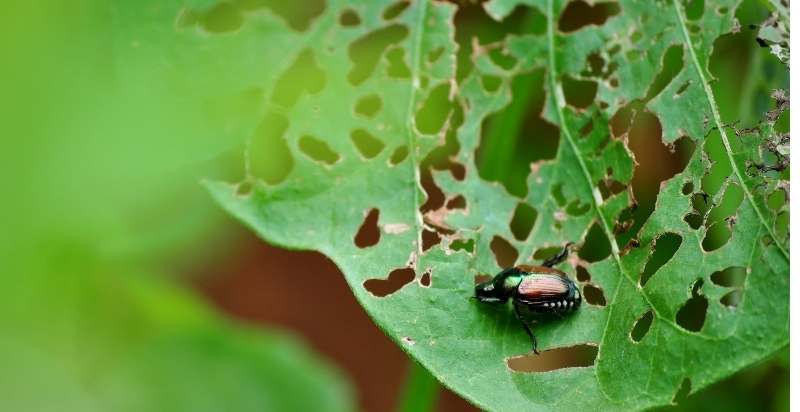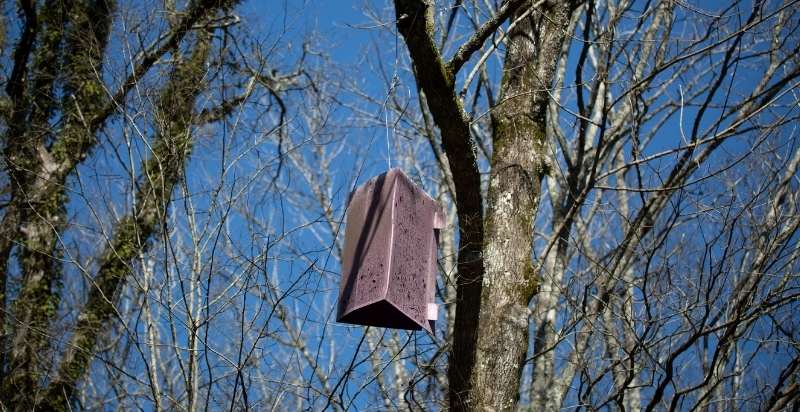Japanese Beetles are a type of plant-eating beetle that is native to Japan. These beetles were first discovered in the United States in 1916, and since then, they have become a major agricultural pest. Japanese Beetles damage plants by eating their leaves and flowers and can also cause indirect damage by infecting plants with diseases.
There are a variety of methods that farmers and gardeners use to control Japanese Beetles. One such method is the use of homemade lures. Homemade lures are made from materials that attract Japanese Beetles, such as rotting fruit, manure, and flowers. Once the beetles are attracted to the lure, they can be trapped and killed.
Homemade lures effectively control Japanese Beetles, but they must be used correctly to work properly. This article will discuss everything you need to know about homemade lures for Japanese Beetles, including how to make them and use them effectively. So let’s start with the basics:
What Are Japanese Beetles?
The Japanese beetle (Popillia japonica) is a species of scarab beetle. The adult measures 15 mm (0.6 in) in length and 10 mm (0.4 in) in width and has a shiny metallic green head and thorax with copper-colored elytra. There are many small bumps on the elytra. Its wing covers, or “elytra,” meet in a straight line down the middle of the back when at rest. Japanese beetles fly about 100 yards (91 m) and are strong fliers. They are most active at night and are attracted to light, so you will see them gather near light sources at night.
The larvae are C-shaped, white grubs with brown heads. They remain underground during the day and come out at night to feed on plant roots. The larvae go through three instar stages before pupating into adults. Adult females burrow into the soil to lay their eggs near the roots of turfgrasses and other plants.
Japanese beetle populations have increased since they were first found in North America in 1916. They are present in all states east of the Mississippi River and Ontario, Canada. The Japanese beetle is a major pest of both field and garden crops, and it attacks more than 300 species of plants, including fruit trees, vegetables, ornamentals, shade trees, and turf grasses.
Life Cycle Of The Japanese Beetle
The Japanese beetle has a one-year life cycle. The adult beetles emerge from the ground in late May or early June. They mate, and the females lay eggs in the soil. The larvae hatch from the eggs and feed on plant roots for about six weeks. They then pupate in the soil and emerge as adults in late August or September. The adults feed on leaves and flowers for about six weeks before burrowing into the ground to overwinter. The Japanese beetle is a major pest of both field and garden crops.
The Japanese Beetle Does Damage:
Japanese beetle damage is easily recognizable. Adults eat the foliage of plants, skeletonizing the leaves and leaving only the veins. They also eat the fruits and flowers of many plants. The larvae (white grubs) feed on the roots of turfgrass and other plants, which can damage or kill the plants.
Japanese beetle damage is most severe in late June and early July, when the adults are actively feeding. Damage usually occurs on the upper surface of leaves, although the undersides may also be eaten. Heavily damaged leaves turn brown and may drop off the plant. Japanese beetles may also damage fruits such as grapes, raspberries, and strawberries.

What Attracts Japanese Beetles?
Japanese Beetles are attracted to a variety of different smells, including the smell of rotting fruit, manure, and flowers. They are also attracted to light colors like white and yellow and beetle pheromones. Though they are not picky eaters, they have some favorite foods, which include roses, grapes, apples, plums, raspberries, and marigolds, to name a few. Therefore, we could think of having some of these attractants as bait in the beetle traps.
Gardeners and farmers can use this information to their advantage by creating homemade lures that Japanese Beetles will be attracted to.
What Are The Benefits Of Homemade Lures For Japanese Beetles?
Homemade lures for Japanese Beetles can provide you with many benefits, including:
- Cost-effectiveness – Creating your own homemade lure for Japanese Beetles can save you much money compared to purchasing commercial products.
- Environmental-friendliness – Most ingredients used in making Homemade Lure for Japanese Beetles are natural and biodegradable, thus causing minimal environmental impact.
- Safety – Commercial products may contain harmful chemicals that can harm your health. On the other hand, homemade lures pose no threat since they only use safe and non-toxic ingredients.
- Convenience – You can easily make Homemade Lures for Japanese Beetles whenever you need them, and there is no need to go out and purchase commercial products.
- Versatility – Homemade Lure for Japanese Beetles can be used in various ways, such as traps, baits, and sprays. This allows you to choose the method that best suits your needs.
It is absolutely easy to create homemade Japanese beetle control, and you can read about the best beetle trap bait recipe below.
How To Make A Homemade Japanese Beetle Lure
Are you wondering whether you can make your own Japanese beetle trap? Yes, you can. There are many recipes for homemade Japanese Beetle lures, but they all contain some combination of the following ingredients:
- Rotting fruit
- Manure
- Flowers
- Yellow paint or fabric
To make a simple homemade Japanese Beetle lure, you will need the following materials:
- A jar or container with a lid
- Rotting fruit (bananas, apples, pears, etc. )
- Manure ( from cows, horses, chickens, etc. )
- A couple of fresh flowers
- Yellow paint or a piece of yellow fabric
Instructions
- Add the rotting fruit and manure to the jar or container.
- Add the flowers and yellow paint or fabric.
- Mix everything well and close the lid tightly.
- Place the lure in an area where Japanese Beetles are a problem. Check it regularly and empty it when it becomes full of beetles
This DIY bait will surely attract Japanese beetles to your trap.
How To Use A Homemade Japanese Beetle Lure
Homemade lures can be used in two different ways: as traps or as bait stations.
Traps
To use a homemade Japanese Beetle lure as a trap, you will need the following materials:
- A jar or container with a lid
- A piece of yellow fabric or yellow paint
- Some rotten fruit or manure
- A funnel
Instructions
- Add rotten fruit or manure to the jar or container.
- Add the yellow fabric or paint.
- Mix everything well and close the lid tightly.
- Place the trap in an area where Japanese Beetles are a problem. The beetles will be attracted to the smell and color of the trap and will crawl inside through the funnel. Check the trap regularly and empty it when it becomes full of beetles.

Bait Stations
Bait stations are more effective for using homemade Japanese Beetle lures but require a bit more work. A bait station is simply a container filled with the lure placed in an area where Japanese Beetles are known to congregate. The beetles will be attracted to the bait station and crawl inside, where they will be trapped.
To make a bait station, you will need the following materials:
- A container or jar with a lid
- Some wire mesh or screen
- Tape or glue
- Rotting fruit or manure
- Yellow paint or fabric
Instructions
- Cut a piece of wire mesh or screen to fit over the top of the container or jar.
- Tape or glue the wire mesh or screen in place.
- Add the rotting fruit or manure to the container.
- Add the yellow paint or fabric.
- Mix everything well and close the lid tightly.
- Place the bait station in an area where Japanese Beetles are a problem. The Beetles will be attracted to the bait station and crawl inside, where they will be trapped. Check the bait station regularly and empty it when it becomes full of beetles.
Few Of The Most Common Prevention Tips:
You can do several things to control Japanese beetles in your garden or field. You can hand-pick the adults and drop them into a bucket of soapy water. You can also trap them with Japanese beetle traps. These traps use a pheromone to attract the beetles, and then they get caught in the trap.
If you have a small number of plants damaged by Japanese beetles, you can protect them with netting or floating row covers, preventing the adults from getting to the plants to feed. Further, vinegar sprays can kill Japanese beetles, but they also kill your plants. Alternatively, there are other methods that you can use, such as using Teaberry oil, peppermint oil, neem oil, chives, and garlic, because the beetles hate the smell.
And if you leave the situation to nature, well, they have some natural enemies such as spiders, raccoons, skunks, moles, and birds like robins, cat birds, and cardinals. However, despite having a great number of predators who feed on Japanese beetles, they have a hard time feeding on the adult members of the species.
You may need to use insecticides if you have a large infestation of Japanese beetles. Be sure to follow the directions on the label carefully. Some insecticides can harm people, pets, and beneficial insects if misused.
Conclusion
Japanese Beetles can be a severe problem for farmers and gardeners, but there are ways to control them using homemade lures. Following this article’s instructions, you can make your own Japanese Beetle lure and use it to trap or bait these pests.
- Everything You Wanted to Know About Red Tamarillos - June 2, 2025
- A Guide to Tulips: Everything You Need to Know & More… - June 2, 2025
- Guanabana: Description, Flavor, Benefits, And Uses - May 27, 2025
